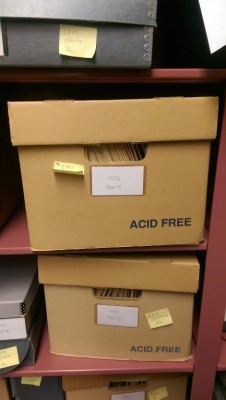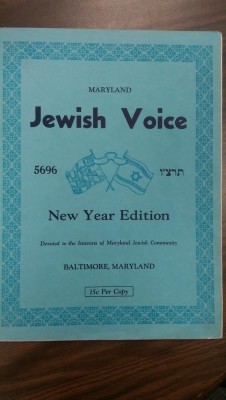The Magic of Magazines

Blog post by Education & Programs Intern Anna Balfanz. To read more posts by and about interns click HERE.
After a few hours of flipping through old magazines, flyers, and ticket stubs, I’m convinced that this category of artifacts contains more information about modern history than anything else. I went into the basement collections to find objects for a Rosh Hashanah exhibit this past week, and became distracted by all of the modern history contained in each box. At first, I stayed focused. I knew which objects and manuscripts to locate and followed the directions to the correct box and dividing folder. My second time down there, however, I lugged the needed box onto the table, opened it, and promptly forgot about staying on-task. In looking for a specific greeting card, I stumbled upon boxes filled with my favorite parts of history.
I struggle to appreciate historical vases, instruments, or other objects; I look at them for a few moments and don’t learn that much about the time period. Written artifacts, however, such as magazines, newspapers, brochures, and flyers give me so much to think about. Looking through a magazine from the 1930s, you see the style of advertising, what they advertised (so many cigarette ads), the style of how people wrote, the words they used, the businesses open, not to mention what people wrote about during that time.

These specific artifacts speak about historical and approaching modern-day Baltimore, an especially interesting subject in terms of race relations, urbanization, and Jewish communities. One brochure for an art program from the 1930s included a large picture of Black and White children working together at the same table, even though Jim Crow laws still operated in Baltimore during that period. Another magazine included an opinion editorial written by a White woman about her (negative) opinion on Black churches and how they’ll affect the economy; an article disturbing in how similar to sounded to articles still published today, with slightly different wording. I held Baltimore first “colored” magazine and Yiddish bulletins for services.

I had to pause to consider all the knowledge buried in these artifacts. When and how did different words begin to be used? How quickly did cigarette ads begin to decline in publications? When did each individual publication begin to include pictures of Black and White people together? How did two different publications tell the same story? In a Playbill, what did the actors look like? What did they include in their bios? What kind of paper did people use for flyers in different neighborhoods? Diaries, letters, and household objects, especially when combined, certainly speak to many people and contain useful information when deconstructing the past and present. For me, however, publications that include words, pictures, ads, and messages directed at the public, the things people absorbed every day, contain more information than anything. Therefore, the chance to see, touch, and flip through such a variety of these sources, from such an interesting and vibrant city, really excites me.
For the record, contemplating research questions and flipping through magazines wasn’t a complete waste of time; I stumbled upon a calendar to use in the Rosh Hashanah exhibit during my wanderings!
